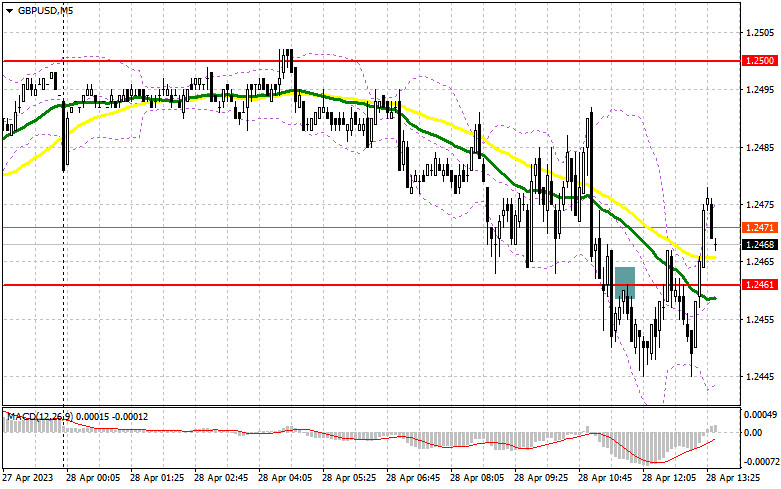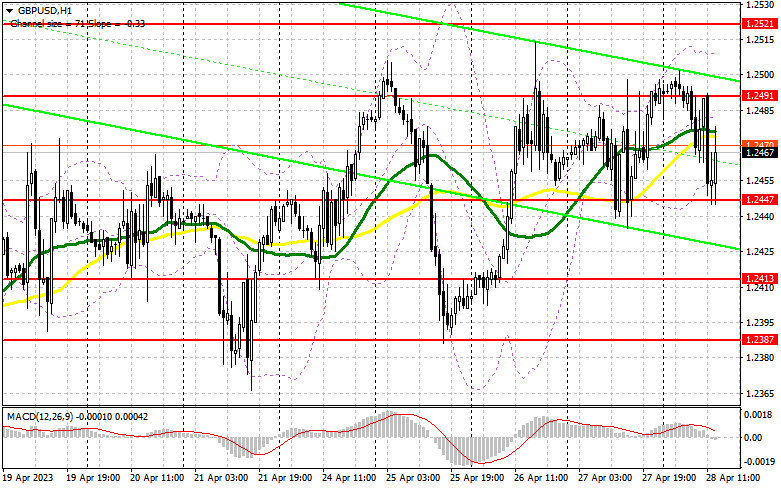
In my morning forecast, I drew attention to the level of 1.2461 and recommended making decisions about entering the market from there. Let's look at the 5-minute chart and figure out what happened there. After the pair's decline to test 1.2461, it was a few points short, so I didn't get a buy signal there. The breakthrough and reverse test of 1.2461 from the bottom to the top gave a good sell signal, but after moving down 10 points, the pressure on the pair weakened. The technical picture was revised for the second half of the day.

To open long positions on GBP/USD, it is required to:
Considering how the pound mercilessly fluctuates in a narrow sideways channel, it is obvious that buyers are not in a hurry to give up positions at the end of the month. Something may change in the second half of the day after the release of reports on the US economy. A large amount of data is expected, which could pressure the pair. Everything depends on the main index of personal consumption expenditures in the US. Its growth will lead to a drop in the pound and certainly a breakthrough of the new support at 1.2447. If the figures match the economists' expectations, and the reports on changes in the level of spending and income of Americans do not surprise me, I bet on the buyers' attempt to break above 1.2491.
To open long positions, I would like to see a false breakout at 1.2447 – support formed during the first half of the day. This will allow a new entry point for long positions, with the prospect of a surge to the area of 1.2491, today's maximum. The breakthrough and reverse test from top to bottom of this range will form an additional signal to buy the pound with a movement to 1.2521. The farthest target will be the area of 1.2543, where I will fix the profit.
In the scenario of a decline to the area of 1.2447 amid a strong Chicago PMI, a good consumer sentiment index from the University of Michigan, and a lack of activity from the bulls, it is best not to rush with purchases. In this case, I will open long positions only on a false breakout in the area of the next support at 1.2413. I plan to buy GBP/USD immediately on a rebound from a minimum of 1.2387, with a correction target of 30–35 points within the day.
To open short positions on GBP/USD, it is required:
Sellers showed themselves but could not cling to the daily lows and the new level of 1.2450. A good scenario would be selling from the level of 1.2491, which could occur after a surge in volatility on the back of multi-directional data from the US. A false breakout in the area of 1.2491 will give the pound a chance to move down again with the prospect of updating the new support at 1.2447. A breakthrough and reverse test from the bottom to the top of this range will increase the pressure on GBP/USD, forming a sell signal with a drop to 1.2413. The farthest target remains a minimum of 1.2387, where I will fix the profit.

In the scenario of GBP/USD growth in the second half of the day and the absence of activity at 1.2491, which is also quite likely, it is best to postpone sales until the test of the next resistance at 1.2521. Only a false breakout there will provide an entry point for short positions. In the absence of downward movement there, I will sell GBP/USD on a rebound immediately from the maximum of 1.2543, but only in expectation of a 30-35 point correction within the day.
The COT report (Commitment of Traders) for April 11 showed an increase in long positions and a decrease in short positions. The latest data from the UK leaves traders hopeful for further interest rate hikes in the UK, maintaining interest in the pound. Given that the Federal Reserve's aggressive policy is ending, and the Bank of England has no choice but to continue raising interest rates to combat double-digit inflation, demand for the pound can be expected to persist. The correction will be a good reason to enter long positions. The latest COT report states that non-commercial short positions decreased by 3,882 to 57,326, while non-commercial long positions jumped by 8,513 to 54,928. This led to a sharp reduction in the negative value of the non-commercial net position to -2,398 compared to -14,793 a week earlier. The reduction has been happening for the third week in a row, which also confirms the bullish nature of the market. The weekly closing price dropped to 1.2440 from 1.2519.
Indicator signals:
Moving averages
Trading occurs around the 30- and 50-day moving averages, indicating market equilibrium.
Note: The author considers the period and prices of the moving averages on the H1 hourly chart and differs from the general definition of classical daily moving averages on the D1 daily chart.
Bollinger Bands
In the event of a decline, the lower boundary of the indicator at 1.2455 will act as support.
Indicator description
• Moving average (determines the current trend by smoothing volatility and noise). Period 50. Marked in yellow on the chart.
• Moving average (determines the current trend by smoothing volatility and noise). Period 30. Marked in green on the chart.
• MACD indicator (Moving Average Convergence/Divergence - convergence/divergence of moving averages) Fast EMA period 12. Slow EMA period 26. SMA period 9
• Bollinger Bands. Period 20
• Non-commercial traders - speculators such as individual traders, hedge funds, and large institutions using the futures market for speculative purposes and meeting certain requirements.
• Long non-commercial positions represent the total long open positions of non-commercial traders.
• Short non-commercial positions represent the total short open position of non-commercial traders.
• The total non-commercial net position is the difference between the short and long positions of non-commercial traders.